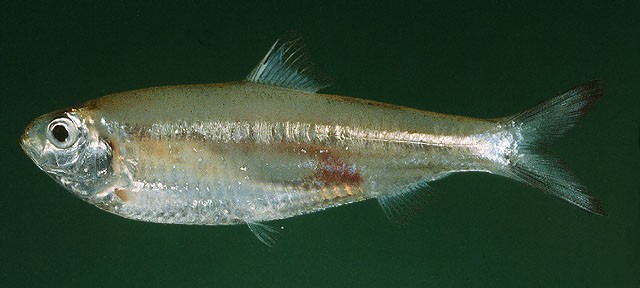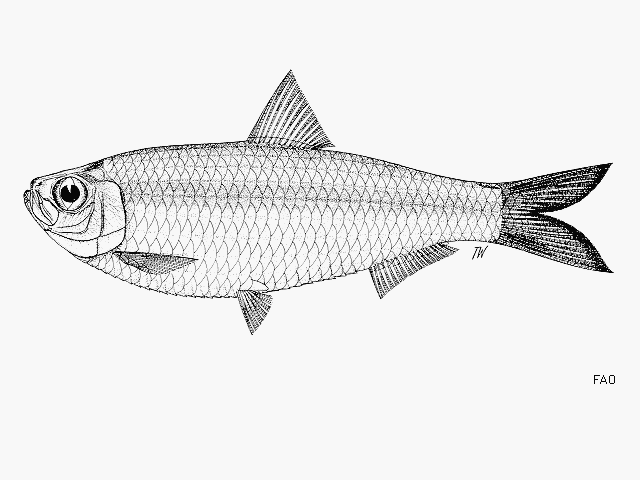Escualosa
thoracata
(Valenciennes,
1847)
White sardine
View all media / Upload your photos and videos
Expand all
Classification / Names
Teleostei (teleosts) > Clupeiformes (Herrings) >
Dorosomatidae (Gizzard shads and sardinellas)
Etymology: Escualosa: Latin, squaleus, squalidus = with rough skin + Latin, alausa = a fish cited by Ausonius and Latin, halec = pickle, dealing with the Greek word hals = salt; it is also the old Saxon name for shad = "alli" ; 1591 (Ref. 45335).
More on author:
Valenciennes.
Environment / milieu / depth range / climate zone / distribution range
Distribution
Indo-West Pacific: northern Indian Ocean (Karachi eastward to Rangoon) to Thailand, Indonesia (Java Sea), the Philippines, Papua New Guinea, and Australia.
Maps

Escualosa thoracata / Native range
AquaMaps Data sources:
GBIF
OBIS
This map was computer-generated and has not yet been reviewed.

Escualosa thoracata / Suitable habitat
AquaMaps Data sources:
GBIF
OBIS
This map was computer-generated and has not yet been reviewed.

Escualosa thoracata / Point map
AquaMaps Data sources:
GBIF
OBIS
This map was computer-generated and has not yet been reviewed.

Escualosa thoracata / Year 2050
AquaMaps Data sources:
GBIF
OBIS
This map was computer-generated and has not yet been reviewed.
Length at first maturity / Size / Weight / Age
Short description
Dorsal spines (total): 0; Dorsal soft rays (total): 13 - 21; Anal spines: 0; Anal soft rays: 14 - 19. Belly strongly keeled. The almost rectangular second supra-maxilla and the bright silver stripe along the flank distinguish it from juveniles of Sardinella, Amblygaster and Herklotsichthys. Resembles some pellonulines with a silver stripe, but they lack a first supra-maxilla. Distinguished from E. elongata of the Gulf of Thailand but its deeper body and broader silver stripe.
Biology
Forms schools in shallow waters, the juveniles apparently entering the lower parts of rivers, but returning later to the sea. Feeds on both zooplankton (copepods, crab zoea, larvae of bivalves and fish eggs) and phytoplankton. Breeds from October to February (mainly November to January) off western coast of India, usually in relatively shallow inshore waters. Marketed fresh and dried-salted.
Main reference
Whitehead, P.J.P. 1985 FAO Species Catalogue. Vol. 7. Clupeoid fishes of the world (suborder Clupeoidei). An annotated and illustrated catalogue of the herrings, sardines, pilchards, sprats, shads, anchovies and wolf-herrings. FAO Fish. Synop. 125(7/1):1-303. Rome: FAO. (Ref. 188)
IUCN Red List Status (Ref. 125652)
Least Concern (LC); date assessed: February 28 2017
CITES (Ref. 131153)
Not Evaluated
CMS (Ref. 116361)
Not Evaluated
Threat to humans
Harmless
More information
- Countries
- FAO areas
- Ecosystems
- Occurrences
- Introductions
- Stocks
- Ecology
- Diet
- Food items
- Food consumption
- Ration
- Common names
- Synonyms
- Metabolism
- Predators
- Ecotoxicology
- Reproduction
- Maturity
- Spawning
- Spawning aggregation
- Fecundity
- Eggs
- Egg development
- Age/Size
- Growth
- Length-weight
- Length-length
- Length-frequencies
- Morphometrics
- Morphology
- Larvae
- Larval dynamics
- Recruitment
- Abundance
- References
- Aquaculture
- Aquaculture profile
- Strains
- Genetics
- Allele frequencies
- Heritability
- Diseases
- Processing
- Mass conversion
- Vision
- Pictures
- Stamps, Coins Misc.
- Sounds
- Ciguatera
- Speed
- Swim. type
- Gill area
- Otoliths
- Brains
Estimates based on models
Preferred temperature (Ref. 123201): 26.7 - 29.1, mean 28.4 °C (based on 1160 cells).
Phylogenetic diversity index (Ref. 82804): PD50 = 0.75 [Uniqueness, from 0.5 = low to 2.0 = high].
Bayesian length-weight: a=0.00851 (0.00745 - 0.00972), b=3.06 (3.02 - 3.10), in cm total length, based on LWR estimates for this species (Ref. 93245).
Trophic level (Ref. 69278): 3.2 ±0.1 se; Based on diet studies.
Generation time: 0.6 ( na - na) years. Estimated as median ln(3)/K based on 2 growth studies.
Resilience (Ref. 120179): High, minimum population doubling time less than 15 months (K=1.82; Fec=7,720; tmax=1).
Fishing vulnerability (Ref. 59153): Low vulnerability (10 of 100).
Price category (Ref. 80766): Low; Very questionable: based on ex-vessel price for species in this family.
Nutrients (Ref. 124155): Calcium = 479 [229, 1,053] mg/100g; Iron = 3.32 [1.94, 5.79] mg/100g; Protein = 18.8 [17.7, 19.9] %; Omega3 = 0.471 [0.232, 0.956] g/100g; Selenium = 49 [22, 104] μg/100g; VitaminA = 23.9 [9.6, 55.9] μg/100g; Zinc = 2.6 [1.7, 4.0] mg/100g (wet weight);



